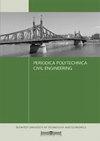新老混凝土界面约束收缩预测
IF 1.4
4区 工程技术
Q3 ENGINEERING, CIVIL
引用次数: 0
摘要
本研究的重点是新老混凝土之间的收缩差异,这种差异会导致界面粘结面出现裂缝。考察了减缩外加剂(SRA)掺量、玄武岩纤维(BF)掺量和新老混凝土界面粗糙度等因素对混凝土收缩的影响。本研究对9组新旧混凝土复合试件进行了收缩试验,收集了试验数据。推导了约束收缩力学模型(RSMM),提出了基于灰色关联分析的约束收缩模型(RMGC)。通过与实验数据的比较,评价了两种预测方法的有效性和方便性。结果表明,RMGC更有效、更方便。此外,研究发现,随着SRA和BF含量的增加,收缩率减小。SRA的作用更为显著。随着RI的增大,收缩率先增大后减小。这项研究可以为使用新旧混凝土的结构的设计和施工提供信息。本文章由计算机程序翻译,如有差异,请以英文原文为准。
Prediction of Restrained Shrinkage of New-to-old Concrete Interface
The focus of this study is on the shrinkage differences between new and old concrete, which can cause cracks at the bonding surface of the interface. The effects of various factors on shrinkage, such as the content of shrinkage reducing admixtures (SRA) the content of basalt fibers (BF) and the roughness at the new-to-old concrete interface (RI) are also examined. In this research, nine groups old-new concrete composite specimens were tested for shrinkage to gather experimental data. The restrained shrinkage mechanical model (RSMM) was deduced, and the restrained shrinkage model based on grey correlation analysis (RMGC) was proposed. The effectiveness and convenience of both prediction methods were evaluated by comparing their results to the experimental data. It was determined that the RMGC was more effective and convenient. Additionally, the research found that as the content of SRA and BF increases, shrinkage decreases. The effect of SRA was found to be more significant. As RI increases, shrinkage undergoes an initial increase and then decreases. The study can be used to inform the design and construction of structures that use both new and old concrete.
求助全文
通过发布文献求助,成功后即可免费获取论文全文。
去求助
来源期刊

Periodica Polytechnica-Civil Engineering
工程技术-工程:土木
CiteScore
3.40
自引率
16.70%
发文量
89
审稿时长
12 months
期刊介绍:
Periodica Polytechnica Civil Engineering is a peer reviewed scientific journal published by the Faculty of Civil Engineering of the Budapest University of Technology and Economics. It was founded in 1957. Publication frequency: quarterly.
Periodica Polytechnica Civil Engineering publishes both research and application oriented papers, in the area of civil engineering.
The main scope of the journal is to publish original research articles in the wide field of civil engineering, including geodesy and surveying, construction materials and engineering geology, photogrammetry and geoinformatics, geotechnics, structural engineering, architectural engineering, structural mechanics, highway and railway engineering, hydraulic and water resources engineering, sanitary and environmental engineering, engineering optimisation and history of civil engineering. The journal is abstracted by several international databases, see the main page.
 求助内容:
求助内容: 应助结果提醒方式:
应助结果提醒方式:


